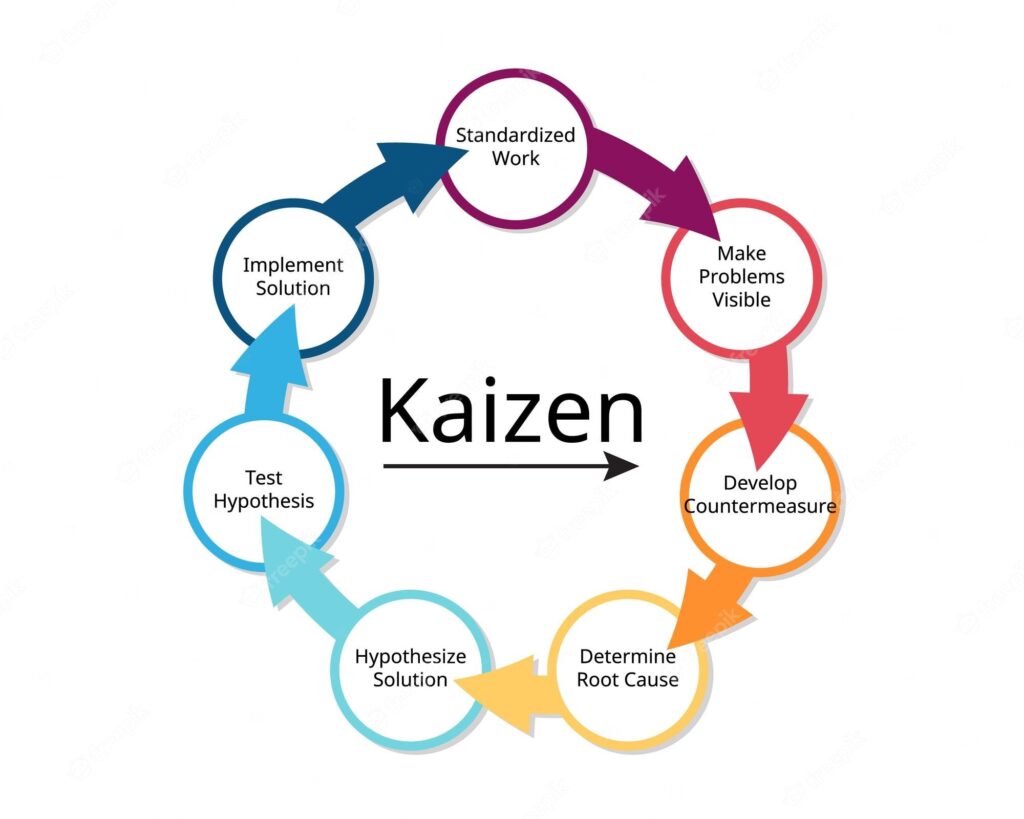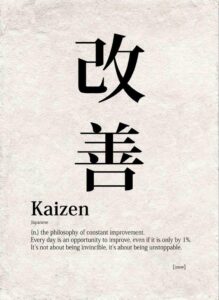In the world of healthcare, efficiency, and effectiveness are key. Patients expect the highest level of care possible, and healthcare providers must constantly strive to meet and exceed those expectations. However, achieving excellence in healthcare is no easy feat. It requires a deep commitment to continuous improvement, and a willingness to embrace new ideas and approaches. This is where the concept of Kaizen in Healthcare becomes relevant and impactful.
Kaizen is a Japanese term that means “continuous improvement”, and it has become a popular philosophy in many industries, including healthcare. By focusing on small, incremental improvements, healthcare providers can make significant strides towards better patient outcomes, improved efficiency, and higher levels of satisfaction.
Kai = Change
Zen = Good

Image Source: FreeImages
What is Kaizen?
Kaizen is a philosophy that originated in Japan after World War II, as a way to rebuild the country’s manufacturing industry. The idea behind kaizen is simple: continuous improvement. It’s a process of making small, incremental changes to improve efficiency, quality, and productivity. The goal is to create a culture of continuous improvement where everyone is involved in identifying problems and finding solutions and continually improving the processes they are involved in. It involves everyone in an organization, from the top-level management to the front-line staff.
The principles of kaizen can be applied to any industry, including healthcare. In healthcare, the focus is on improving patient outcomes, reducing waste, and increasing efficiency. By making small, incremental improvements, healthcare providers can create a culture of continuous improvement that leads to better patient care and outcomes.
Kaizen is not a one-time occurrence or a simple remedy. It requires a lasting commitment to continuous improvement.
Kaizen Methodology
The kaizen methodology is a structured approach to continuous improvement. It involves the following steps:
- Identify the problem: The first step in the kaizen methodology is to identify the problem. This involves gathering data, analyzing the data, and identifying the root cause of the problem.
- Develop a solution: Once the problem has been identified, the next step is to develop a solution. This involves brainstorming ideas, evaluating options, and selecting the best solution.
- Implement the solution: The third step is to implement the solution. This involves making the necessary changes to the process or system and testing the solution to ensure that it is effective.
- Monitor and evaluate: The final step is to monitor and evaluate the solution. This involves tracking the results, measuring the impact of the solution, and making adjustments as needed.
The kaizen methodology is a continuous cycle of improvement. Once a solution has been implemented, the process starts again with the identification of a new problem.

How to Implement Kaizen in a Healthcare Setting
Implementing kaizen in a healthcare setting requires a commitment from everyone in the organization. Here are some steps that healthcare providers can take to implement kaizen:
- Get buy-in from leadership: The first step in implementing kaizen is to get buy-in from leadership. Leaders need to be committed to the process and willing to invest the time and resources needed to make it successful.
- Train staff: Healthcare providers need to train their staff on the principles of kaizen and how to implement it. This can include training on problem-solving tools and techniques, as well as how to identify and eliminate waste in processes.
- Identify areas for improvement: Healthcare providers need to identify areas for improvement. This can involve gathering data, analyzing processes, and identifying areas where improvements can be made.
- Involve everyone: Kaizen involves everyone in an organization, from the top-level management to the front-line staff. Everyone needs to be involved in identifying problems and finding solutions.
- Implement small changes: Kaizen is all about making small, incremental changes. Healthcare providers should start with small changes that can be implemented quickly and easily, and then build on those changes over time.
Kaizen Tools and Techniques
There are many tools and techniques that healthcare providers can use to implement kaizen. Some of the most common tools and techniques include:
- Process mapping: Process mapping is a tool that healthcare providers can use to visualize their processes and identify areas for improvement.
- Gemba walks: Gemba walks involve going to the place where the work is done and observing the process in action. This can help healthcare providers to identify waste and inefficiencies in the process.
- 5S: 5S is a workplace organization tool that can help healthcare providers to create a more organized and efficient workplace.
- Root cause analysis: Root cause analysis is a problem-solving technique that can help healthcare providers to identify the underlying cause of a problem.
- Plan-Do-Check-Act (PDCA): PDCA is a four-step cycle for continuous improvement that involves planning, implementing, monitoring, and evaluating.
Challenges and Limitations of Kaizen
While kaizen can be a powerful tool for improving healthcare outcomes, there are also challenges and limitations to its implementation. Some of the key challenges and limitations include:
- Resistance to change: Kaizen involves making changes to processes and systems, which can be difficult for some people to accept.
- Lack of resources: Implementing kaizen requires time and resources, which may not be available in all healthcare settings.
- Limited scope: Kaizen is focused on incremental improvements, which may not address larger systemic issues in healthcare.
- Lack of leadership support: Without support from leadership, kaizen initiatives may not be successful.
- Cultural barriers: Kaizen originated in Japan and may not be well understood or accepted in all healthcare settings everywhere.
Examples of Successful Kaizen Implementations in Healthcare
There are many examples of successful kaizen implementations in healthcare. One example is the Virginia Mason Medical Center in Seattle, which implemented kaizen to improve patient safety and reduce waste. By focusing on small, incremental improvements, Virginia Mason was able to reduce medication errors by 82% and reduce hospital-acquired infections by 90%.
Another example is the Cincinnati Children’s Hospital Medical Center, which implemented kaizen to improve patient flow and reduce wait times. By making small, incremental improvements to their processes, Cincinnati Children’s was able to reduce wait times by 80%.
Measuring the Success of Kaizen in Healthcare
When it comes to assessing the success of kaizen in healthcare, measuring its impact can present a challenge. However, there are several crucial metrics that healthcare providers can employ to evaluate the effectiveness of kaizen initiatives. These metrics include:
- Patient outcomes: Evaluating the impact of kaizen on patient outcomes is vital. This can involve measuring improvements in areas such as medication error rates or the incidence of hospital-acquired infections.
- Efficiency: This entails measuring changes in wait times or increases in throughput, enabling healthcare providers to gauge the effectiveness of their improvement efforts.
- Staff satisfaction: To assess the impact of kaizen on staff satisfaction and engagement, healthcare organizations can utilize various methods, with surveys and feedback mechanisms being particularly effective. By administering well-designed surveys, organizations can gather valuable insights into employees’ perceptions and experiences related to the kaizen initiatives implemented.
In addition to surveys, organizations can also conduct focus groups, open forums, or one-on-one conversations to delve deeper into staff satisfaction and engagement levels. - Financial impact: Evaluating the financial impact of kaizen is of great importance. This involves measuring cost reductions, such as decreased waste or streamlined processes, as well as identifying potential revenue increases resulting from improved efficiency and quality.
Kaizen is a powerful tool for improving healthcare outcomes. By focusing on small, incremental improvements, healthcare providers can make significant strides towards better patient outcomes, improved efficiency, and higher levels of satisfaction. While there are challenges and limitations to implementing kaizen in healthcare, the benefits are clear. As healthcare continues to evolve, kaizen will continue to play an important role in creating a culture of continuous improvement and driving better outcomes for patients and providers.
There is an excellent article by Kaizen Institute on How Kaizen can assist hospitals
